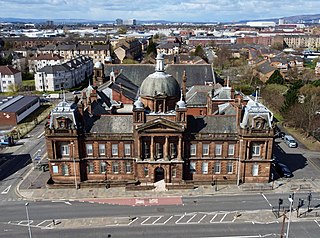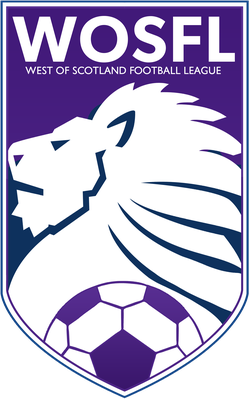
Govan is a district, parish, and former burgh now part of south-west City of Glasgow, Scotland. It is situated 2.5 miles (4.0 km) west of Glasgow city centre, on the south bank of the River Clyde, opposite the mouth of the River Kelvin and the district of Partick. Historically it was part of the County of Lanark.

Benburb Football Club is a Scottish football club, based in Govan, Glasgow. Formed in 1885, the club is a member of the Scottish Junior Football Association and currently competes in the West of Scotland Football League. Benburb's colours are blue and white.

Linthouse is a neighbourhood in the city of Glasgow, Scotland. It is situated directly south of the River Clyde and lies immediately west of Govan, with other adjacent areas including Shieldhall and the Southern General Hospital to the west, and Drumoyne to the south. Although it is currently located within the Govan ward of Glasgow City Council, it was in fact a distinct area separate from Govan until 1901 when it willfully became part of the Burgh of Govan in turn both areas were annexed to Glasgow in 1912.

Hampden Park in Glasgow is the primary home stadium for the Scotland national football team. This has been the case since 1906, soon after it opened. The present site of Hampden Park is the third location to bear that name and both the previous locations also hosted Scotland games. Scotland have also played many of their home games in other stadiums throughout their history, both in friendly matches and for competitive tournaments.
Linthouse Football Club was a football club from the Linthouse district of Govan, Scotland. The club played in navy blue.
The Scottish League XI was a representative side of the Scottish Football League. The team regularly played against the (English) Football League and other national league select teams between 1892 and 1980. For a long period the annual fixture between the English and Scottish leagues was only second in importance to the matches between the two national teams. The fixture declined in importance after regular European club competition was instituted in the 1950s; matches in the 1960s and 1970s were played irregularly and poorly attended. A match involving a Scottish League XI was last played in 1990, to mark the centenary of the League.

John Campbell was a Scottish footballer, who played for Celtic, Aston Villa, Third Lanark and the Scotland national team.
John Bell Barker was a Scottish footballer who played for Linthouse, Rangers and the Scotland national team in the 1890s.
Dundee Wanderers Football Club was a football club based in Dundee, Scotland. They were formed in 1894 as a result of a merger between two local clubs, Wanderers and Strathmore. The club was briefly a member of the Scottish Football League (SFL), playing in Division Two during the 1894–95 season, but after finishing second from bottom of the league they failed re-election. In December 1894 the suffered an all-time record SFL defeat, losing 15–1 to Airdrieonians. Their home ground was Clepington Park.
Allan Martin was a Scottish footballer who played for Rangers, Leith Athletic, Celtic and Hibernian. He finished as the top scorer in the Scottish Football League Division One in the 1895–96 season.
Braehead Park, originally known as Hibernian Park, was a football ground in the Oatlands area of Glasgow, Scotland. It was the home ground of Glasgow Hibernian from 1889 until 1890, then used by Thistle from 1892 until they folded in 1895.
Hyde Park was a football ground in the Springburn area of Glasgow, Scotland. It was the home ground of Northern throughout their existence.
New Logie Green was a football ground in the Powderhall area of Edinburgh, Scotland. It was the home ground of St Bernard's from 1889 until 1899, and was also used to host the 1896 Scottish Cup final, the only time the Scottish Cup final has been played outside Glasgow. The ground was named after a nearby mansion.
Ibrox Park was a football ground in Ibrox, Scotland. It was the home ground of Rangers from 1887 until they moved to the adjacent second Ibrox in 1899. The ground staged the Scottish Cup Final four times and also three Scotland international matches.
Bridgeton Waverley Football Club was a Scottish football club based in Glasgow. Originally founded in 1904, they competed in the Junior grade from 1923 until folding in 1962.
Inchview was a football ground in the Whiteinch area of Glasgow, Scotland. It was the home ground of Partick from the 1870s until 1885, and of Partick Thistle from 1885 until 1897.

William Loudon Wardrope was a Scottish footballer who played in the Football League for Middlesbrough and Newcastle United, mainly as an outside left.

The West of Scotland Football League (WoSFL) is a senior football league based in the west of Scotland. The league sits at levels 6–10 on the Scottish football league system, acting as a feeder to the Lowland Football League.
The 2021–22 West of Scotland Football League was the 2nd season of the West of Scotland Football League, with its top division as part of the sixth tier of the Scottish football pyramid system. The season began on 17 July 2021.
Whitefield Football Club was a Scottish association football club based in Govan, now part of Glasgow.







